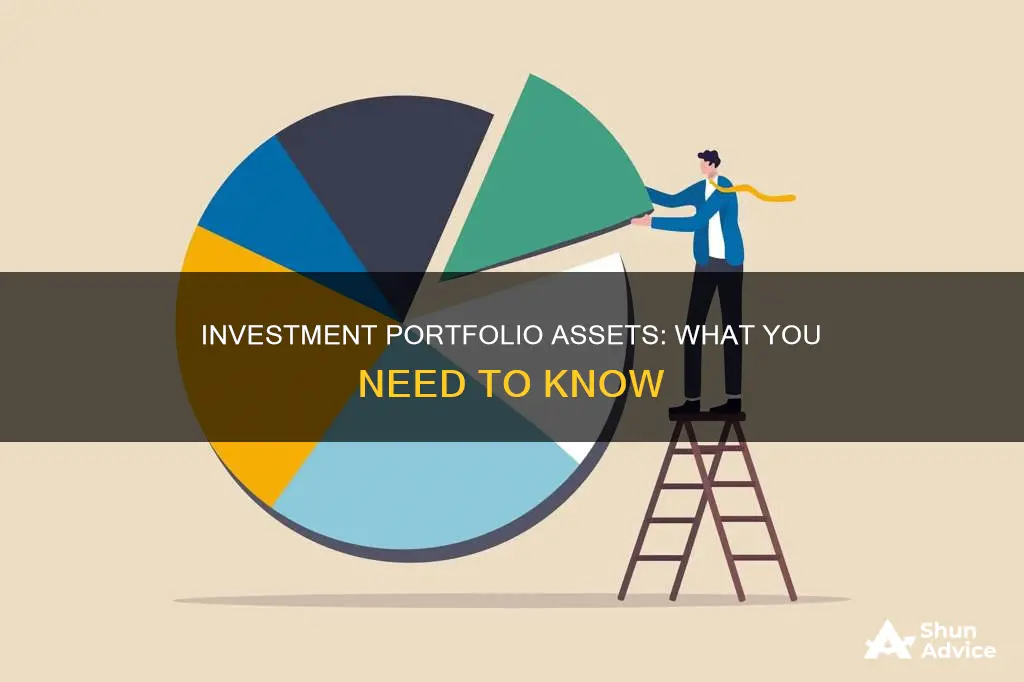
An investment portfolio is a collection of financial investments, such as stocks, bonds, commodities, cash, and cash equivalents, including closed-end funds and exchange-traded funds (ETFs). The term portfolio refers to all of an individual's or institution's invested assets.
The assets in an investment portfolio can vary depending on the investor's goals, risk tolerance, and time horizon. Some common assets found in investment portfolios include:
- Stocks
- Bonds
- Mutual Funds
- Exchange-Traded Funds (ETFs)
- Real Estate
- Commodities
- Cryptocurrencies
- Private Equity
- Hedge Funds
The key to a successful investment portfolio is diversification, which helps to reduce risk and maximise returns. Diversification involves spreading investments across different asset classes, sectors, and geographical regions. It is important to regularly review and rebalance an investment portfolio to maintain the desired asset allocation.
| Characteristics | Values |
|---|---|
| Definition | A collection of financial investments |
| Purpose | To generate interest and increase financial gains |
| Types of Assets | Stocks, bonds, commodities, cash, cash equivalents, real estate, art, private investments, mutual funds, exchange-traded funds (ETFs), gold, cryptocurrencies, private equity, hedge funds |
| Diversification | Different types of assets to reduce risk and increase returns |
| Risk Tolerance | Depends on age, financial goals, and personality |
| Investment Style | Passive (index funds) or active (individual stocks) |
| Asset Allocation | Depends on risk tolerance and financial goals |
| Rebalancing | Periodically reassess and adjust portfolio to maintain desired asset allocation |
What You'll Learn

Stocks
There are several types of stocks to consider:
- Growth stocks: These are stocks of companies that are experiencing faster revenue, cash flow, and earnings growth compared to their peers.
- Value stocks: Value stocks are shares of solid and healthy companies that are currently undervalued due to larger market factors beyond the company's control.
- Dividend stocks: Companies that pay out regular dividends are often favoured by investors seeking a steady stream of income.
- Blue-chip stocks: These are stocks of well-known, established companies like Apple, Disney, and Microsoft. Blue-chip stocks have a track record of strong performance and consistent dividend payments.
When investing in stocks, it's important to consider your risk tolerance and financial goals. Stocks can be volatile, and there is always the possibility of losing money if the company's performance declines. To mitigate this risk, many investors opt for stock funds, such as index funds, mutual funds, or exchange-traded funds (ETFs), which provide exposure to a diverse range of companies.
To purchase stocks, you'll need a brokerage account, such as an individual retirement account (IRA) or a taxable brokerage account. It's recommended to hold stocks as part of a well-diversified portfolio that includes other asset classes like bonds, cash, and real estate.
Invest Wisely: Strategies to Earn 100K Annually
You may want to see also

Bonds
When investing in bonds, there are several factors to consider, including the coupon (the interest rate of the bond), maturity (the date the bond will mature and the principal amount will be returned), bond type, and credit rating. Bonds can be purchased individually or through bond funds, which offer more diversification but less control over the underlying bonds.
The proportion of bonds in a portfolio often depends on the investor's risk tolerance and time horizon. Generally, the lower the risk tolerance and the closer the investor is to retirement, the higher the proportion of bonds in the portfolio. For example, a conservative portfolio might allocate 50% or more to bonds, while an aggressive portfolio might have a lower bond allocation and focus more on stocks.
It's important to regularly monitor and rebalance a portfolio to ensure it aligns with the investor's goals and risk tolerance. This may involve selling some bonds and buying other assets to adjust the weightings of the portfolio back to the desired allocation.
Equities Allocation: How Much is Too Much?
You may want to see also

Real estate
There are four basic forms of real estate investment: private equity (direct ownership), publicly traded equity (indirect ownership claim), private debt (direct mortgage lending), and publicly traded debt (securitized mortgages).
The motivations for investing in real estate income property include current income, price appreciation, inflation hedge, diversification, and tax benefits. Real estate investments can also produce income from rents or mortgage payments in addition to the potential for capital gains.
When investing in real estate, it is important to consider factors such as location, lease structures, and economic factors such as economic growth, population growth, employment growth, and consumer spending, as these can affect the value of the property.
There are several ways to invest in real estate, including:
- Rental properties: This option is suitable for individuals with DIY skills, patience to manage tenants, and time to manage the property. It requires substantial cash upfront to finance maintenance and cover periods of vacancy or non-payment of rent.
- Real estate investment groups (REIGs): REIGs are ideal for those who want to own rental real estate without the hassle of hands-on management. They pool money from multiple investors, similar to a small mutual fund, and invest in rental properties. A company operating the REIG collectively manages all the units and takes a percentage of the monthly rent.
- House flipping: Flippers look for undervalued properties and aim to sell them quickly for a profit. This requires significant experience in real estate valuation, marketing, and renovation.
- Real estate investment trusts (REITs): REITs are suitable for investors who want portfolio exposure to real estate without making a traditional real estate transaction. They are bought and sold on major exchanges like stocks, and the corporations behind them must pay out 90% of their taxable profits as dividends to maintain their REIT status.
- Online real estate platforms: These platforms, also known as real estate crowdfunding, allow investors to join others in investing in large commercial or residential deals. They offer the opportunity to diversify into real estate without putting up a large stake.
The typical minimum investment in real estate varies depending on the investment strategy. Direct investments, such as purchasing a rental property, usually require a higher upfront cost compared to indirect investments like REITs or real estate crowdfunding.
Overall, real estate can be a valuable component of a well-diversified portfolio, offering potential benefits such as income generation, capital appreciation, and diversification.
Investment Manager: A Career in Finance and Management
You may want to see also

Mutual funds and ETFs
Mutual funds and exchange-traded funds (ETFs) are two popular investment vehicles that allow investors to diversify their portfolios. They are similar in that they both provide investors with access to a wide range of securities, such as stocks, bonds, and other assets, and are overseen by professional fund managers. However, there are some key differences between the two.
Mutual funds have been around for a longer period compared to ETFs, which are relatively new. Mutual funds are usually actively managed, meaning fund managers make decisions about how to allocate assets to beat the market. As a result, they tend to have higher fees and expense ratios. The purchase and sale of mutual fund shares occur directly between investors and the fund provider, and the price is determined at the end of the trading day based on the net asset value (NAV). Mutual funds also typically have higher minimum investment requirements, ranging from $500 to $5,000.
On the other hand, ETFs are passively managed and track a market index or sector sub-index. They trade on exchanges like stocks, giving them intra-day liquidity, and can be bought and sold throughout the trading day. ETFs are often cheaper to invest in, with a minimum investment requirement of just one share. Additionally, ETFs offer tax advantages as they are passively managed and tend to realise fewer capital gains than actively managed mutual funds.
When deciding between mutual funds and ETFs, investors should consider their investment goals, risk tolerance, and investment style. Mutual funds may be suitable for those seeking more hands-on professional management and a more structured approach, while ETFs offer flexibility and are attractive to cost-conscious investors.
Understanding Private Portfolio Investments: What, Why, and How?
You may want to see also

Commodities
Commodity prices are primarily driven by global supply and demand, as well as seasonality and fluctuations specific to each good. They can also be influenced by weather, geopolitical events, and economic cycles. As a result, commodity prices can be highly volatile, offering the potential for high returns but also significant risk.
There are several ways for investors to gain exposure to commodities:
- Direct ownership: This involves owning the physical goods, which can be costly and may require specialised storage.
- Futures contracts: These are derivative financial instruments whose value is based on the expected future value of the underlying commodity.
- Commodity-linked ETFs and mutual funds: These funds invest in a basket of commodities or commodity-related companies, providing diversification and easier access for investors.
- Shares in commodity-producing companies: This allows investors to gain indirect exposure to commodities by investing in companies that produce or rely heavily on them.
When considering commodity investments, it is important to keep in mind that they often have low liquidity, can be difficult to buy or sell quickly, and are associated with higher potential returns and higher risk. Additionally, they require a greater degree of specialised knowledge or expertise compared to more traditional investments.
Encouraging Corporations to Invest in Green Energy
You may want to see also
Frequently asked questions
An investment portfolio is a collection of different assets owned by an individual or institution. It can include stocks, bonds, real estate, commodities, and more.
There are several types of investment portfolios, but the main categories are growth, income, value, defensive, and blended. Each type has a different risk/reward profile, with growth portfolios being more aggressive and defensive portfolios being more conservative.
Diversification is a risk management strategy that involves spreading your investments across different asset classes, sectors, and geographical regions. It helps to reduce the impact of any single asset's performance on the overall portfolio and can lead to more stable returns.
The selection of assets depends on your financial goals, risk tolerance, and investment timeline. It's important to diversify across different asset classes and choose a mix of investments that align with your risk profile. Regularly reviewing and rebalancing your portfolio is also crucial to maintain your desired asset allocation.







